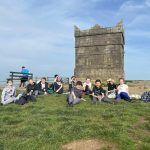Intent and the School Vision
Geography at Millbrook teaches pupils the knowledge, skills and understanding to make sense of their world.
The curriculum is designed to have a balance of core knowledge (facts, location, names, vocabulary) and a sense of place (senses, emotions, values, opinions) in order to develop a knowledge and understanding of real places as well as how people affect the environment and are influenced by it.
We aim to inspire children from an early age to think about their own place in the world, the environment, their rights and responsibilities to other people. Within Early Years, the themes are taught through ‘Understanding of the World’ where they will learn about people, culture and communities as well as the natural world.
Through the study of Geography children are given wider opportunities to develop an understanding of their surroundings, other places, and how people use their environment.
Children are encouraged to broaden their knowledge of places and environments from throughout the world, develop an understanding of maps and atlases as well as problem solving skills inside and outside the classroom. Our pupils are introduced to techniques, to undertake fieldwork and geographical enquiries.
Implementation
At Millbrook, pupils explore the 4 areas of the geography curriculum, applying and building on previous learning each year.
- Location knowledge
Pupils learn about the local area and beyond, including the United Kingdom, Europe and North and South America. Pupils find out about continents, oceans, countries and major cities, as well as human and physical characteristics; and how some of these aspects have changed over time. Pupils identify the position and significance of latitude, longitude, Equator, Northern Hemisphere, Southern Hemisphere, the Tropics of Cancer and Capricorn, Arctic and Antarctic Circle, and time zones. - Place knowledge
Pupils explore the similarities and differences of human and physical geography of regions within the United Kingdom, Europe, a region within North or South America and Africa. - Geographical Processes
Pupils learn about key physical characteristics, including: climate zones, rivers, mountains, volcanoes and the water cycle, as well as human characteristics, including: types of settlement and land use, economic activity and the distribution of natural resources including energy, food, minerals and water. - Geographical skills and fieldwork
Pupils use maps, atlases, globes and digital/computer mapping to locate countries and describe features. They use the eight points of a compass, four and six-figure grid references, symbols and key to build their knowledge of the United Kingdom and wider world. Pupils use fieldwork to observe, measure, record and present the human and physical features in the local areas using a range of methods, including sketch maps, plans and graphs, and digital technologies.








